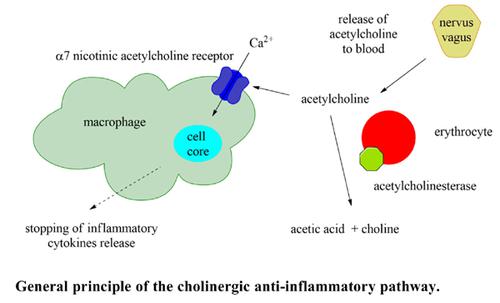Mini-Reviews in Medicinal Chemistry ( IF 3.3 ) Pub Date : 2021-03-31 , DOI: 10.2174/1389557520666201117111715 Miroslav Pohanka 1

|
The cholinergic anti-inflammatory pathway is a part of the parasympathetic nervous system and it can also be entitled as an anti-inflammatory reflex. It consists of terminations of the vagal nerve into blood, acetylcholine released from the terminations, macrophages and other cells having α7 nicotinic acetylcholine receptor (α7 nAChR), calcium ions crossing through the receptor and interacting with nuclear factors, and erythrocytes with acetylcholinesterase (AChE) terminating the neurotransmission. Stopping of inflammatory cytokines production is the major task for the cholinergic antiinflammatory pathway. The cholinergic anti-inflammatory pathway can be stimulated or suppressed by agonizing or antagonizing α7 nAChR or by inhibition of AChE. This review is focused on cholinergic anti-inflammatory pathway regulation by drugs. Compounds that inhibit cholinesterases (for instance, huperzine, rivastigmine, galantamine), and their impact on the cholinergic anti-inflammatory pathway are discussed here and a survey of actual literature is provided.
中文翻译:

胆碱能抗炎途径在感染性疾病和炎性病理中的药理学影响
胆碱能抗炎途径是副交感神经系统的一部分,也可以称为抗炎反射。它由迷走神经的末端进入血液,从末端释放的乙酰胆碱,巨噬细胞和其他具有α7烟碱型乙酰胆碱受体(α7nAChR)的细胞,穿过该受体并与核因子相互作用的钙离子以及具有乙酰胆碱酯酶(AChE)的红细胞组成终止神经传递。停止炎性细胞因子的产生是胆碱能抗炎途径的主要任务。可以通过激动或拮抗α7nAChR或通过抑制AChE来刺激或抑制胆碱能抗炎途径。这篇综述的重点是药物对胆碱能抗炎途径的调控。











































 京公网安备 11010802027423号
京公网安备 11010802027423号